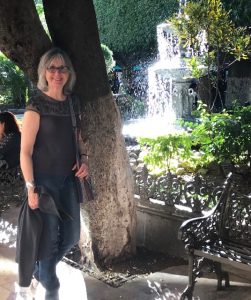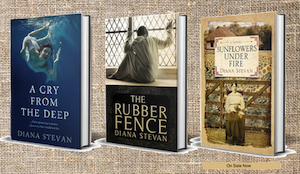25th April 2019
One age-old discussion in writing circles is the ‘writing about what you know’ concept. This implies staying within your own experience and many writers immediately bristle, saying ‘No-one wants to hear about my life’. But – as ever – the trick lies in what you make of it. That’s where originality comes in. This month’s author on the blog, Diana Stevan, is a case in point. She has written Sunflowers Under Fire starting with the true facts of her family history. And what a story it has become!

Lizzie: Welcome, Diana!
Diana Stevan: Thank you, Lizzie. And thank you again for doing this.
Lizzie: So could we begin with a brief summary of the story in Sunflowers Under Fire?
Diana: Yes of course. Soon after her husband volunteers for the Tsar’s army, a Ukrainian farm wife and her six children flee from the invading Germans only to face the trials of a refugee camp, typhus, unimaginable losses and her daughter’s forbidden love. How much can one woman take? In this saga, love and loss are bound together in a country always at war. Sunflowers Under Fire is an intimate novel that illuminates the strength of the human spirit. Based on the true stories of my grandmother’s ordeals, I have tried to capture the voices of those who had little say in a country that is still being fought over.

Lizzie: They say all fiction is autobiographical. What is the most significant event/setting for you personally in the story and why?
Diana: For me personally the most significant event in this story happens in the earlier part of the novel. It’s when baby Eudokia (my mother) is gravely ill and has an encounter with royalty on a refugee train. I had some information about it but again, this is fiction, so I had to research those times and that place to do justice to the tale.
Lizzie: So, when writing, do you like to plan in detail or set up a situation and see where it takes your characters?
Diana: When writing, I’m very much a pantster which means I have some idea of where I’m going in the story but I don’t always know how I’m going to get there. I like the characters guiding me for much of the way. In Sunflowers Under Fire, I had an outline, based on my mother’s anecdotes, and I organized them chronologically. But what I had were essentially bare bones. It took me a while to get into the heart and mind of Lukia Mazurets, my grandmother. Though I shared a bedroom with her for the first fifteen years of my life, she never talked about her past in the old country.
Lizzie: Where and when would you like to set another novel? Why?
Diana: I have so many ideas but I’m thinking of doing a sequel to Sunflowers Under Fire, set during the Great Depression in Canada. The 1930s was a very difficult period for many Canadians (also Americans) due to the fall of the stock market in 1929 and the drought that hit the mid-west. It was especially hard on immigrants who left their countries for a dream that fell apart not long after they’d arrived.
Lizzie: Is there an important theme (or themes) that this story illustrates?
Diana: Faith will get you through the most horrific times. War does not solve a problem; it only makes matters worse. And a mother who loves her family will do anything to make sure her children are safe and secure.
Lizzie: What is the role of superstition and tradition or innovation and dystopia in this story?
Diana: Lukia Mazurets is superstitious and relies on her dream book to give her answers. To say more, would give away some key turning points in this story.
Lizzie: What do you learn about change and social classes in this book?
Diana: Because this story is set during World War I in Russia, the reader is confronted by the differences between how the royals lived and how the peasants lived. It was the reason for the Bolshevik revolution. The poor had had enough.
Lizzie: Thank you so much, Diana, for your insights as to how you can illustrate huge themes through the prism of one family’s experiences (fictionalised, of course).

Author Diana Stevan has worked as a family therapist, teacher, actor, and CBC sports reporter. She’s published poetry, a short story, newspaper articles, a novelette The Blue Nightgown and two other novels, A Cry From The Deep and The Rubber Fence. She lives in West Vancouver and Campbell River with her husband.

To find out more about Diana Stevan and her work, see her author website. She can also be contacted through Twitter, Instagram, Facebook, LinkedIn and Pinterest.
To buy her books, see:
Kobo:
